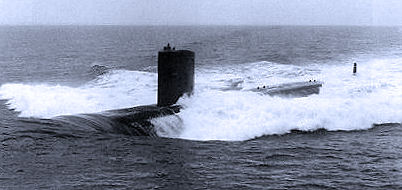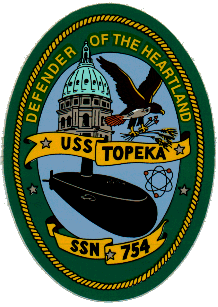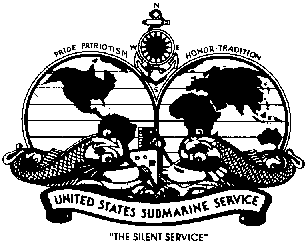|
Copy of a painting of USS Topeka SSN 754
The Honorable Elizabeth Hanford Dole, With that, the fourth generation of a Navy ship bearing the name TOPEKA was launched. ( Note: CL 67 and CLG 8 are counted as two ships, even though they occupied the same hull.) USS TOPEKA (SSN 754) was commissioned October 21, 1989, with Commander Timothy M. Richert as her first Commanding Officer. TOPEKA is the fourth ship of the "improved" LOS ANGELES Class, the Navy's newest and world's best nuclear powered attack submarines. These ships are the most advanced undersea vessels of their type in the world. Their missions include locating and destroying surface ships and submarines; reconnaissance, mine planting, and operations with special warfare elements. This 360-foot, 6900-ton ship is well equipped to accomplish these tasks. Faster than her predecessors and equipped with a highly accurate sonar and weapon control system, the ship can be armed with sophisticated Mark 48 and ADCAP torpedoes, as well as HARPOON land/anti-ship missiles. TOPEKA can also launch multipurpose TOMAHAWK cruise missiles from vertical tubes located in the bow or from her torpedo tubes. Other significant improvements include: full under-ice operational capability, improved ship quieting, onboard over-the-horizon targeting capability, two towed sonar arrays, and retractable bow planes. TOPEKA arrived her new home port, San Diego, Tuesday, May 21, 1991. Note: TOPEKA, as a submarine, may be a bit hard for us surface sailors to understand. Quoting an ole Kansas saying (well Midwestern), "God only meant us to go high enough to pick corn, and low enough to dig potatoes." But we welcome you to the U. S. Navy, and we are proud that you carry the same name we carried and defended in so many places around the world.
A SHORT HISTORY OF SUBMARINE PAY Should Teddy Roosevelt be the patron saint of submariners? Roosevelt was the first American President to go aboard a submarine and to make a dive. Roosevelt ventured beneath the waters of Long Island Sound aboard USS Plunger (SS 2) on March 25.1905. Plunger was the United States' second submarine, commissioned in September 1903. Beyond this historical first, however, is the fact that Roosevelt was the man directly responsible for submarine pay. The Naval hierarchy in 1905 considered submarine duty neither unusual nor dangerous, and classified it as shore duty. Therefore, submariners received twenty-five percent less pay than sailors going to sea in Destroyers. Cruisers and similar surface ships. Roosevelt’s two-hour trip on Plunger convinced him that this discrimination was unfair. He described submarine duty as hazardous and difficult. and he found that submariners "have to be trained to the highest possible point as well as to show iron nerve in order to be of any use in their positions..." Roosevelt directed that officer service on submarines be equated with duty on surface ships. Enlisted men qualified in submarines were to receive ten dollars per month in addition to the pay of their rating. They were also to be paid a dollar for every day in which they were submerged while underway. Enlisted men assigned to submarines but not yet qualified received an additional five dollars per month. Roosevelt did not dilly-dally once he made a decision. He issued an Executive Order directing the extra pay for enlisted personnel. This was the beginning of submarine pay! FROM THE SACRAMENTO CHAPTER PERISCOPE SUB INSIGNIA HAS DISTINGUISHED BACKGROUND
The origin of the U.S. Navy's Submarine Service insignia dates back to 1923. On 13 June of that year, Captain Ernest King, USN, later to become Fleet Admiral and Chief of Naval Operations during world War II, and at that time Commander Submarine Division 3, suggested to the Secretary of the Navy, via the Bureau of Navigation (now BUPERS), that a distinguishing device for qualified submariners be adopted. He submitted a pen-and ink sketch of his own, showing a shield mounted on the beam end of a submarine, with dolphins forward of, and abaft, the conning tower. The suggestion was strongly endorsed by Commander Submarine Divisions, Atlantic. During the next several months, the Bureau of Navigation solicited additional designs from several sources. Among the designs were a submarine and shark motif, a submarine and shield, and submarines and dolphins. A Philadelphia firm, which had done work for the Navy previously, was approached with the request that it undertake to design a suitable badge. Two designs were submitted by the firm and these were combined into a single design. It was the design in use today, a bow view of a submarine, proceeding on the surface, with bow planes rigged for diving, flanked by dolphins in a horizontal position with their heads resting on the upper edge of the bow planes. On 20 March 1924, the Chief of Navigation recommended to the Secretary of the Navy that the design be adopted. The recommendation was accepted by Theodore Roosevelt Jr., Acting Secretary of the Navy. The submarine insignia was to be worn at all times by officers and men qualified in submarine duty attached to submarine units or organizations, ashore or afloat, and not to be worn when not attached. In 1941, the Uniform Regulations were modified to permit officers and men who were eligible to wear the submarine insignia to wear that insignia after they had been assigned to other duties in the naval service, unless such right had been revoked. The officers insignia was a bronze, gold-plated metal pin, worn centered above the left breast pocket and above the ribbons or medals. Enlisted men wore the insignia, embroidered in silk, in white on blue for blue clothing, and in blue on white for white clothing. This was sewn on the outside of the right sleeve, midway between the wrist and the elbow. The device was two and three quarter Inches long. In 1943, the Uniform Regulations were modified to provide that "enlisted men, who are qualified for submarine duty and are subsequently promoted to commissioned or warrant ranks may wear enlisted submarine insignia on the left breast until they qualify as submarine officers, at which time this insignia would be replaced by the officers' submarine pin." In mid-1947, the embroidered device shifted from the sleeve of the enlisted men's Jumper to above the left breast pocket. A change to Uniform Regulations dated 21 September 1950 authorized the embroidered insignia for officers (in addition to pin-on Insignia) and a bronze, silver-plated, pin-on insignia for enlisted men (in addition to the embroidered device).
|



